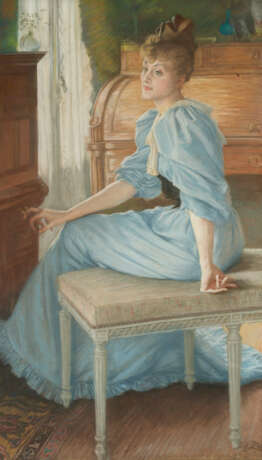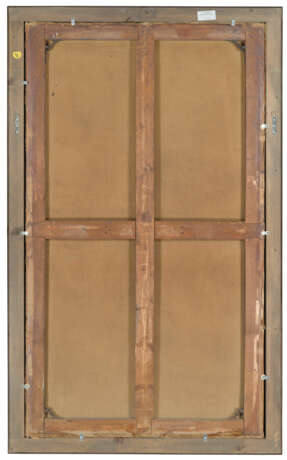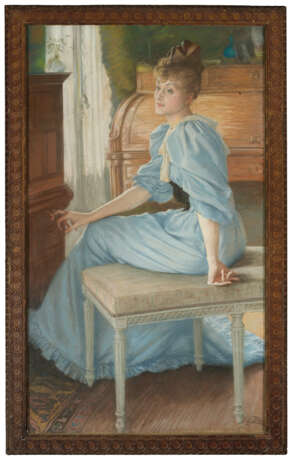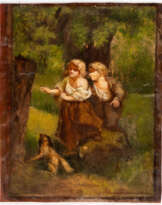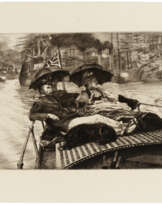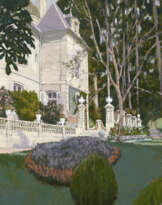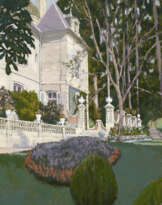ID 1172945
Lot 126 | JAMES JACQUES JOSEPH TISSOT (NANTES 1836-1906 CHENECEY-BUILLON)
Estimate value
€ 80 000 – 120 000
Portrait de Madame Henriette de Bonnières
signé ‘J Tissot’ (en bas à droite)
pastel sur papier marouflé sur toile et monté sur châssis
162,5 x 94 cm (64 x 37 in.)
Provenance
Madame de Henriette de Bonnières (1854-1906), château Grossoeuvre, Évreux (Normandie).
Madame de la Chennecières, château de Cierey, Cirey-sur-Blaise (Haute-Marne).
Collection particulière, Suisse.
Vente Christie’s, Londres, 26 juin 2007, lot 219.
Literature
W. Misfeldt, The Albums of James Tissot, Bowling Green, 1982, p. 111, pl. IV-28, ill (comme Portrait de femme non identifiée).
C. Sciama, ‘Un héros proustien ? James Tissot et le processus de la mémoire’, James Tissot. L’Ambigu moderne, cat. exp., Paris, Musé d’Orsay, 2020, p. 250, n. 6.
Further details
JAMES JACQUES JOSEPH TISSOT, PORTRAIT OF HENRIETTE DE BONNIÈRES, PASTEL ON PAPER, LAID DOWN ON CANVAS, SIGNED
Tissot’s return to Paris after eleven years in London in 1882 coincided with the revival of pastel portraiture. Giovanni Boldini, Paul-César Helleu, Jean-Louis Forain, Edgar Degas and Jacques-Émile Blanche were among the leading artists who executed worldly portraits in this medium, often of previously unmatched size, in a highly naturalistic style.
Like his friends Boldini and Forain, Tissot had a natural taste for wealth and elegance, and embarked on the creation of portraits of Parisian high society, adapting his talents to the demands of his patrons. In 1883, James Tissot’s first monographic exhibition opened in Paris at the Union centrale des arts décoratifs, further enhancing his reputation among Parisian society. He was keen to show an ensemble representative of the great diversity of his work, including paintings, enamels, drawings and even engravings (James Tissot. L'Ambigu moderne, exhib. cat., Paris, Musée d’Orsay, 2020, p. 272).
The model pictured here, Henriette de Bonnières, née Arnand Jeanti (1850-1905), married to Robert de Bonnières, an influential journalist of Le Figaro, ran a famous literary salon, attended by the likes of Alphonse Daudet, Anatole France, Henri de Régnier and José-Maria de Heredia. The young woman was also friends with many artists, and her portrait was painted by Pierre-Auguste Renoir at the age of 35 (fig. 1; Musée des Beaux-Arts de la Ville de Paris, Paris, Petit Palais, inv. PPP2364). In Renoir’s portrait, she is also shown seated and wearing a blue dress, leaning on a small table. Likewise, in this pastel, she is surrounded by 18th-century furniture: a cylinder desk, a bench and a double cabinet. The strongly oblique perspective, relaxed pose and size of this work are typical of large pastel portraits by Tissot of the period. The pensive pose of the model and the desk in the background allude to her status in the intellectual world of Paris. In this large, well-preserved pastel, Tissot subtly combines a palette of cool colours – the pale blue of the dress and the vivid greens of the background – warmed by the golden yellow of the light reflected on the roll-top desk.
| Artist: | James Tissot (1836 - 1902) |
|---|---|
| Applied technique: | Pastel on paper |
| Medium: | Canvas, Textile |
| Genre: | Portrait |
| Place of origin: | England, Northern Europe, Europe, United Kingdom |
| Auction house category: | All other types of objects, Paintings, Watercolors, Drawings, Drawings, Watercolors and drawings |
| Artist: | James Tissot (1836 - 1902) |
|---|---|
| Applied technique: | Pastel on paper |
| Medium: | Canvas, Textile |
| Genre: | Portrait |
| Place of origin: | England, Northern Europe, Europe, United Kingdom |
| Auction house category: | All other types of objects, Paintings, Watercolors, Drawings, Drawings, Watercolors and drawings |
| Address of auction |
CHRISTIE'S 9 Avenue Matignon 75008 Paris France | ||||||||||||||
|---|---|---|---|---|---|---|---|---|---|---|---|---|---|---|---|
| Preview |
| ||||||||||||||
| Phone | +33 (0)1 40 76 85 85 | ||||||||||||||
| Fax | +33 (0)1 40 76 85 86 | ||||||||||||||
| Conditions of purchase | Conditions of purchase | ||||||||||||||
| Shipping |
Postal service Courier service pickup by yourself | ||||||||||||||
| Payment methods |
Wire Transfer | ||||||||||||||
| Business hours | Business hours
|
